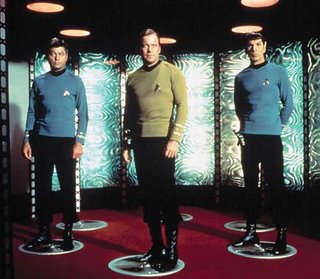|
Star Gate Facts Transporter Technology |
|
|
..
Teleportation
Takes Quantum Leap Austrian researchers have teleported photons (particles of light) across the Danube River in Vienna using technology that calls to mind Scotty beaming up Captain Kirk in the science fiction series. "We were able to perform a quantum teleportation experiment for the first time ever outside a university laboratory," said Rupert Ursin, a researcher at the Institute for Experimental Physics at the University of Vienna in Austria. The researchers read the "blueprints" of the photons they wanted to teleport. They then broke up the photons into smaller particles called quantum bits and sent these bits, along with the blueprints, through a fiber-optic cable in a sewage pipe under the river. At the other end, replicas of the
original photons were created. The original photons
ceased to exist once the replicas were created.
Quantum teleportation may have progressed from science fiction to reality. But don't look for a Star Trek transporter anytime soon. This science has little to do with beaming people from one place to another. Instead, scientists hope the technology could become crucial for quantum computing and quantum cryptology, areas that promise to make computing much faster and 100 percent secure. The research is reported in this week's issue of the science journal Nature. Disappearing Act Teleportation involves dematerializing an object at one point and transferring the precise details of its configuration to another location, where the object is then reconstructed. In quantum teleportation tiny units of computer information, called quantum bits, are transferred from one place to another. The technology is called teleportation because the information moved behaves more like an object than normal information. "If you're writing an e-mail, you're sending [something] into a cable where it will travel and then come out at the other end," Ursin said. "But with quantum teleportation, you will not find the [full] information that you sent inside the cable. It's taken apart and put back together at the other end." Teleportation was long considered impossible because it violates the so-called uncertainty principle of quantum mechanics. As the principle goes, the act of measuring a tiny particle destroys it. So theoretically, an exact replica of a particle can never be made. But in 1993 scientists showed a way around the problem by using a complex concept known as entanglement, an area of physics that Albert Einstein referred to as "spooky action at a distance." Since then, numerous experiments using photons have proved that quantum teleportation is possible. Scientists have teleported quantum bits along more than a mile (1.6 kilometers) of fiber-optic wire inside laboratories. The science is not new, said Mark Kuzyk, a physics professor at Washington State University in Pullman. But this is the first time "researchers have demonstrated that teleportation works in the kinds of real-life conditions that are found in telecom applications." No Eavesdropping The most obvious practical application for quantum teleportation is in cryptology. Scientists say quantum physics can provide a completely secure method of communication between two distant correspondents. Sending photons entangled in a quantum state makes it impossible for an eavesdropper to intercept a message. "There is no copy [of the information], so there is nothing to intercept," Ursin said. The problem, for now, is that the quantum technology only works over limited distances. Physicists are now laying the groundwork for so-called quantum repeaters. Used in regular communications, these devices would allow messages to be transmitted around the world. Commercial applications remain far off. "But this is really the step toward a real-world implementation of a long-distance quantum teleportation protocol," Ursin said. So what are the chances of developing a transporter that can beam people from one location to another, Star Trek-style? "Nothing we do will help us build Scotty's apparatus," Ursin said. "The reason is very simple: A human body contains too much information to scan and build all replicas." For a human to be teleported, a machine would have to pinpoint and analyze the trillions and trillions of atoms that make up the human body. Only recently have scientists taken preliminary steps toward teleporting even a single, whole atom. SOURCE: National Geographic |
|
| FAIR USE NOTICE: This page contains copyrighted material the use of which has not been specifically authorized by the copyright owner. Pegasus Research Consortium distributes this material without profit to those who have expressed a prior interest in receiving the included information for research and educational purposes. We believe this constitutes a fair use of any such copyrighted material as provided for in 17 U.S.C § 107. If you wish to use copyrighted material from this site for purposes of your own that go beyond fair use, you must obtain permission from the copyright owner. | |
|
|

